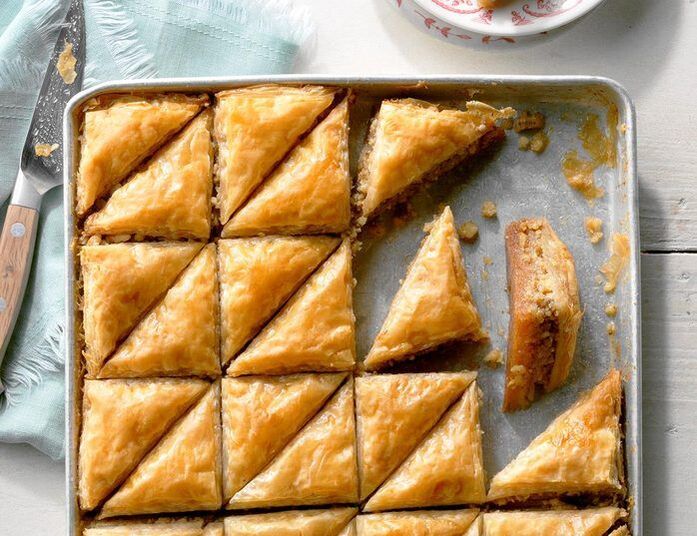Baklava (/bɑːkləˈvɑː, ˈbɑːkləvɑː/,or /bəˈklɑːvə/ is a layered pastry dessert made of filo (phyllo) pastry, filled with chopped nuts, and sweetened with syrup. It is one of the most popular and best known worldwide sweet pastries of Turkish cuisine. It’s easy to make, but does require a little care, so allow time to follow all the steps carefully. You will be rewarded! Freezes well – serves a crowd.
Baklava
METHOD:
Notes:
- In a food processor, pulse the pistachios until coarsely ground (or you can chop them by hand until very finely chopped). Don’t overprocess -they should maintain some texture.
- Clarify the butter by melting it over low heat, then letting it cook until the foam rises to the top and the milk solids fall to the bottom of the pan. This will take about 5 to 15 minutes depending upon how high your heat is, but don’t rush it or the butter could burn.
- Skim foam off the top of the melted butter. Line a fine-mesh sieve with a piece of cheesecloth, place it over a bowl and pour the melted butter through.
- Heat oven to 350F/180C and brush the inside of a 9-by-13-inch (33 x 23 cm) baking pan with a little of the clarified butter.
- Prepare the phyllo dough by trimming the stack of it with scissors to fit the bottom of your baking dish. Cover phyllo layers with a lightly damp kitchen towel and keep covered.
- Place 1 piece of phyllo on the bottom of the baking pan; brush lightly with clarified butter. Layer phyllo sheets on top, brushing each sheet with butter as you go, until half the phyllo is used.
- Spread nuts on phyllo in an even layer, then layer with remaining phyllo, brushing each sheet with butter as you go (rewarm butter if necessary).
- Cut the pastry into 36 pieces, using clean up-and-down strokes, and rotating the pan if necessary. Make sure to cut all the way through to bottom of pan. Pour any remaining butter evenly over pan.
- Bake baklava until the top is golden brown, and the lower phyllo layers beneath the pistachios are thoroughly baked through. To test this, use a knife to lift a corner of one of the pastry rectangles from the centre of the pan to see the bottom layers. Start checking after 40 minutes, but it could take an hour or even 1 hour 10 minutes. If the top starts to get too brown before the pastry is cooked through, lay a piece of foil over the top.
- Meanwhile, prepare sugar syrup: In a medium pot, combine sugar with 1 2/3 cups/400 mls water. Bring to a boil, then let simmer for 10 minutes, until slightly thickened. Stir in lemon juice. Cool.
- When the baklava is baked through, remove pan from oven and place on a rimmed baking sheet to catch any drips of syrup. Slowly pour cooled sugar syrup over the pastry. Serve at room temperature.
Notes:
- Do not thaw the phyllo pastry for too long before using or it will get sticky.
- To make it more decadent, us a combination of walnuts and pistachios and increase the quantity. You can also use almonds if you wish.
- Ensure the syrup is cold when added to the hot baklava. It results in the syrup being well absorbed into the pastry and will yield crunchy pastry.
- It’s essential that you cut the baklava into pieces before baking. If you do it after baking, it will crumble.

